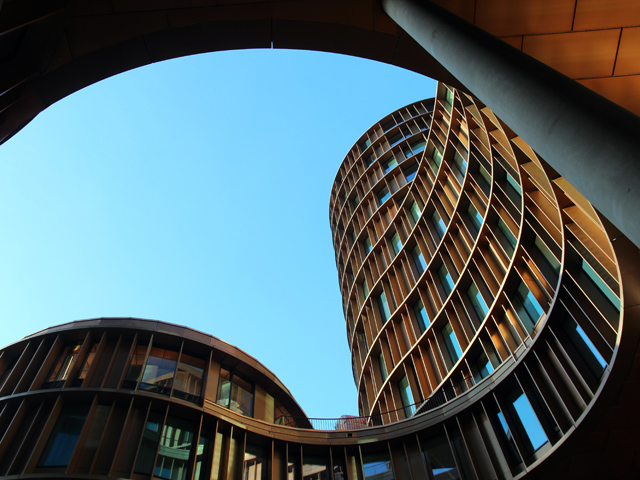Where will innovation in architecture come from next?
Now more than ever, architecture is in need of innovation. The pandemic has made us fundamentally rethink the functioning of our cities, public spaces, buildings, and homes.
Meanwhile, the recent Black Lives Matter and racial justice protests have us questioning architecture’s complicity in broader socioeconomic issues. These challenges are pressing, and we cannot put off changes any longer.

GALLERY
But even before these crises forced many of us to re-examine architecture, the industry was in desperate need of innovation. A 2017 McKinsey report stated that global construction “has evolved at a glacial pace.” Even accounting for the great size of the sector—$10 trillion is annually spent on construction, the report found—productivity is declining. How can we identify and develop the innovation necessary to change this notoriously slow-moving industry?
In a previous article, I wrote about how to structure an analysis of architectural innovation. The article’s main thesis was born from my experiences in architectural practice and education. As an architect, I’ve designed and built projects using non-conventional materials borrowed from the automotive and aerospace industries. Fiberglass-reinforced plastic, mass timber, and other cutting-edge materials I’ve worked with remain uncommon, however, and have yet to be taken up by architects in great numbers. Since migrating into the academy, I’ve noticed a similar gap: The skillsets inculcated in architecture schools do not line up with those needed for practice, and little to nothing is taught about the multi-faceted process of building. The end result is that the industry fails to understand innovation even when it happens to produce it.
To this state of affairs, I proposed an analytical framework for locating opportunities for material innovation at different points of the design-build process, specifically: (1) architectural purpose or ambition, (2) the AEC process, and (3) the life-cycle perspective. It is from these three “cornerstones,” I have argued, that future architectural innovations will come. To better grasp how this method operates in practice, it is worth discussing each cornerstone in greater depth.
The first cornerstone establishes the importance of a clear declaration of architectural ambition and scope. This is a vital step because it acknowledges the incredible diversity of purposes and goals—all valid in their own way—inherent to any design endeavour. Architects may work on grand churches, civic buildings, commercial buildings, multi-family housing, retail, interior fit-outs, or temporary disaster relief shelters. All these project types do vastly different things and demand vastly different criteria for judging their success. We can reasonably expect that the “appropriate” design solutions for each type will be correspondingly diverse; after all, a material or technology that is suitable for an airport may not be the same as one for an ADU (additional dwelling unit).
The articulation of a clear architectural ambition serves additional purposes. For one, it is essential in marshalling the many stakeholders in any given endeavour towards a shared goal. Architecture is necessarily collaborative, and, moreover, often involves the broader public, so the clarity and transparency of that purpose are paramount. Secondly, this statement of intent defines the criteria by which subsequent decisions in the AEC (architecture, engineering, and construction) chain will be made. If a stated architectural goal is declared clearly, it may then be easy to see why a particular design solution or material choice is, or isn’t, appropriate.
But more than anything, a novel ambition is a source of innovation. Necessity being the mother of invention, defining an architectural ambition is identifying a need. Sustainability is a great example. Although the UN had already defined them in 1987, sustainability concerns were only slowly integrated into the building profession over the subsequent three decades. Today, sustainability occupies a big part of the building industry, with myriad certification companies, consultants, and products vying for a greater and greater share of project budgets. The incorporation of ecological goals in architecture has meant that we have partially redefined what a building does or, at any rate, should do. Currently, we are continuing to rethink what our buildings need to do, and wellness and social equity concerns are becoming more and more important. Make no mistake, these ambitions are the seeds of innovation. And with that comes a change in material, form, and program.
Hampering that change, however, is the notoriously convoluted and sluggish AEC process. An understanding of this process forms the second cornerstone of my framework. A simple building can take upwards of two years to move from conception through occupancy, while larger, complex projects can easily take a decade. Every step of the way, bureaucratic, legal, technical, economic, social, and political systems engage with architecture in complex ways.
While it would take far too long to explain all of the activities subsumed within the AEC process, we might parse it into the following three phases: (1) feasibility, (2) design & engineering, and (3) construction. In the feasibility phase, the interested parties determine the viability of a particular building project, which generally involves assessing the availability of land, the applicable zoning and building codes, and the financial and economic implications of construction. Design & engineering is the phase where we first encounter “architecture,” loosely defined as developing a design, selecting the materials, engineering the building systems, and drafting the drawings and construction documents for bid. The fulfilment of those construction documents forms that last phase.
The long, complicated, and labour-intensive AEC process is where many proposed innovations find their greatest hurdles—meaning that it is ripe for innovation. In my experience with non-conventional materials that attempt to find a foothold in architecture, it is not a question of their technical suitability, but rather how they fit within the AEC process or not that inhibits their wider adoption. The initial, and most effective, screening occurs within the feasibility phase, where narrowly prescriptive codes pre-emptively exclude non-codified materials and construction techniques, and the financial structures of construction emphasise initial cost over longer-term value.
A misapplication of technologies towards their most suitable phases within the AEC process may explain the slow adoption of certain innovations, such as BIM (building information modelling software). BIM software was initially developed as a tool to improve the efficiency of documentation and coordination during design and engineering, but it proved far more valuable for material management during construction. The result, in many cases at least, was that contractors were first to adopt BIM, with architects following suit. This shows that a good appraisal of an innovation’s impact on the AEC process can influence its rate of adoption.
The third cornerstone is a life-cycle assessment. The concerns of the sustainability movement have brought many additional considerations to the fore of architecture. But one of the most lasting may be a heightened awareness of the impact a building beyond its designed lifespan. This means studying the effects of chosen material procurement, building operation, maintenance, resiliency, and end-of-life processes. In summary, these impacts can be divided into three basic life-cycle phases: (1) embodied, (2) operational, and (3) end-of-life.
In each of these life-cycle phases are opportunities for innovation in the identification, quantification, and measurement of building performance. Can more resilient buildings increase the lifespan and usability? Are there materials with lower maintenance costs but greater durability? Are there sensors or an internet-of-things that can monitor energy use, indoor air quality, or daylighting? As we increasingly demand that our buildings perform effectively from conception through end-of-life, innovations in how we identify, quantify, and measure the performance of a building across a designed lifespan will only grow in importance.
It is important to note that these phases and sub-phases mutually reinforce and support each other. Any proposed innovation or technology needs to have a clear understanding of its strengths and challenges in each phase within the framework, judged against the ambition. Like any structural framework, mine ceases to be effective if one or more elements are compromised, but gains strength if each element and its connections are robust.
Working within this framework we can more accurately weigh the outcome of many decisions. First of all, we can assess the viability of any given proposed technology or innovation. By generating a simple matrix enumerating opportunities versus challenges (or a SWOT analysis) over all phases, we can gain a fuller understanding of that innovation’s potential to accomplish a goal. The ambition is used to assess and weigh the relative advantages and disadvantages of a proposed innovation at each phase. Secondly, we can use this framework to determine the best courses of action to fulfill our spatial ambitions. And we can also use this framework to understand from where meaningful innovation will come in the future.
Buildings are complicated and reflect the complicated nature of contemporary society. We are constantly learning more about our environment and asking our built environment to do more for us. Architecture needs to constantly adapt and change, and the better it can do that, the better it can serve our goals. Proposed innovations in architecture must determine their ambition, figure out ways to measure their success and understand how that changes the process of making a building happen.
Words Quang Truong via ArchDaily
The Committee for Geelong has unveiled an ambitious $1 billion vision to transform the Market Square site from ...
Perched atop a modernist monolith, a 19th-century Lorrain-style house appears to hover above the skyline of Metz, France. This ...
New York-based studio Parts and Labor Design has redefined the classic American diner with its sophisticated refresh of ...












